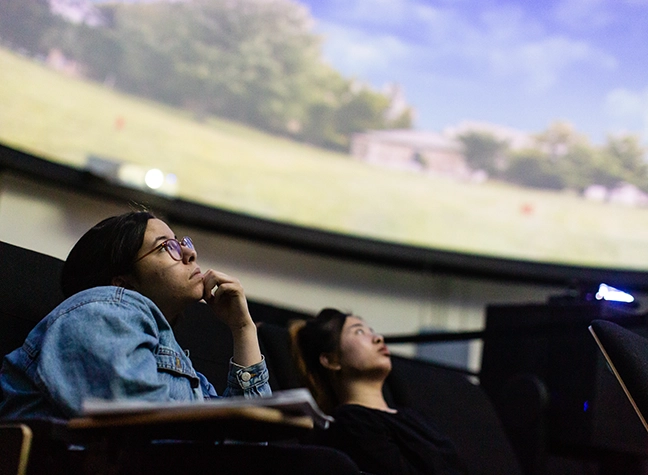"Earth, Moon & Sun": First through eighth grade and general audiences.
Coyote has a razor-sharp wit, but he’s a little confused about what he sees in the sky. Join this amusing character (adapted from American Indian oral traditions) in a fast-paced and fun show that explores lunar phases, eclipses, and other puzzles. Engaging and immersive, Earth, Moon and Sun also examines how humans learn through space exploration. It is a perfect show for school audiences! The show is a production by the UNC Morehead Planetarium and Science Center.
"Dynamic Earth": Fourth grade through high school.
Dynamic Earth explores the inner workings of Earth's great life support system: the global climate. With visualizations based on satellite monitoring data and advanced supercomputer simulations, this cutting edge production follows a trail of energy that flows from the Sun into the interlocking systems that shape our climate: the atmosphere, oceans, and the biosphere. Audiences will ride along on swirling ocean and wind currents, dive into the heart of a monster hurricane, come face-to-face with sharks and gigantic whales, and fly into roiling volcanoes. The show is produced by Spitz Creative Media, NCSA's Advanced Visualization Lab, NASA's SciVis Studio, and Thomas Lucas Productions, Inc., in association with the Denver Museum of Nature & Science and NASA Earth Science. Supported by PA State Film Office. Narrated by Liam Neeson.
"Two Small Pieces of Glass": Sixth grade through high school.
Telescopes help us understand our place in space and telescopes continue to expand our understanding of the Universe. Discover the history of the telescope — an instrument with two small pieces of glass — and the discoveries these wonderful tools have made. See how telescopes work and how the largest observatories in the world use these instruments to explore the mysteries of the universe. While looking through an astronomer’s telescope, you will explore the Galilean Moons, Saturn’s rings, and spiral structure of galaxies and learn about the discoveries of Galileo, Huygens, Newton, Hubble and many others. You’ll be transported to some of the largest observatories in the world, as well as learn about recent NASA missions including the Hubble Space Telescope.
"Solar Superstorms": Fourth grade through high school.
A fury is building on the surface of the Sun—high-velocity jets, a fiery tsunami wave 100,000 kilometers high, rising loops of electrified gas. What's driving these strange phenomena? How will they affect planet Earth? Find the answers as we venture into the seething interior of our star. Solar Superstorms is a major new production that takes viewers into the tangle of magnetic fields and superhot plasma that vent the Sun's rage in dramatic flares, violent solar tornadoes, and the largest eruptions in the solar system: coronal mass ejections. The show features one of the most intensive efforts ever made to visualize the Sun's inner workings, including a series of groundbreaking scientific visualizations computed on the giant supercomputing initiative, Blue Waters, based at the National Center for Supercomputing Applications, University of Illinois. The show is a co-production of Spitz Creative Media, NCSA’s Advanced Visualization Lab, and Thomas Lucas Productions. Narrated by Benedict Cumberbatch with major support from the National Science Foundation and the Pennsylvania State Film Office.
Solar Superstorms explores related content including: The Earth-Sun relationship, Importance of magnetic fields in space, The nature of polar auroras, Space weather and the threat to communications and power networks, Monitoring solar behavior.
"We Are Stars": Fourth grade through high school.
What are we made of? Where did it all come from?
Explore the secrets of our cosmic chemistry, and our explosive origins. Connect life on Earth to the evolution of the Universe by following the formation of Hydrogen atoms to the synthesis of Carbon, and the molecules for life. With expert input from leading scientists, cosmologists, astrophysicists, astro chemists, planetary scientists and astro biologists we present humanity’s current understanding of where everything, including us, came from. Narrated by Andy Serkis, music by Rhian Sheehan.
Covered subject areas: Cosmology, Earth Science, Life Science & Nature, Solar System, Space Science and Astronomy.
"Black Hole: 1st Picture": GA, College, Grades 1-3, 4-5 and 9-12.
Following a journey of human perseverance, ingenuity, and imagination, the full dome film Black Hole First Picture encapsulates a historic milestone in science visualization and discovery – witnessing a phenomenon widely believed to be invisible: a black hole. Planetarium audiences around the world are taken on a quest that examines worldwide radio sites that comprise the Event Horizon Telescope (a global network of synchronized radio observatories that work in unison to capture images of black holes), peers into the core of the Messier 87 galaxy, and travels to the heart of the Milky Way to produce the first-ever picture of a black hole.
Black Hole First Picture showcases stunning cinematography of each site of the Event Horizon Telescope, including real-world footage captured at seven of the eight telescopes. To produce the film, the Cosm Studios team and Writer-Director, Robin Sip, travelled across 10 countries and utilized 3D printing to model the South Pole Telescope. 95 percent of the film is live-action footage, versus CGI. Through the lens of this film, we see the tremendous contributions and impact made by the global science community, inspiring future generations across the globe.
"Beyond the Sun: In Search of a New Earth": Grade 1 and up.
While Celeste is fighting off sleep in her room by reading a book on astronomy she receives an unexpected visit from Moon. Together, they will enjoy a journey through the Universe to discover what exoplanets are and how they can be detected.
They observe rogue planets, oceanic worlds and super-Earths. Moon tells her about exoplanet hunters, who observe the sky in search of planets like Earth. Many adventures are yet to come. But first, she needs some rest. Celeste drops off to sleep waiting for the next visit of Moon.

